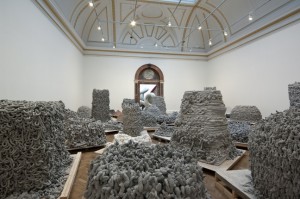Immediate Response
My immediate response to this was a generalization that everything in the art piece was the same smooth randomness. The smooth curves reminded me of dog poop. This art piece initially stimulated a feeling of almost disgust at the accumulation of these smooth tubular shapes. It, however, possessed something appealing about the way the material was accumulated. The shapes had a relaxing effect in that they exuded certain perfection in the confusion of their arrangement. It also elicited a feeling similar to that of a graveyard in the way the formations were erect, not curved formations. This stoic appearance of the formations made them feel like a guardian of something, hiding something, or representing something. One of the formations is wrapped in a smooth, consistent layer, that makes a smooth build up, like stucco of a house, looking like it was wrapped with this material.
Objective Description
As I looked closer, however, I became more aware of what the art piece was. Piles of smooth, similar diameter material were accumulated into a piles. These piles all had specific shapes. Some piles were arranged into shapes with sharp edges while others merely resembled pyrimads or cylinders. All tops of the shapes were flat. I noticed that there was a cylindrical pile with a white material surrounding it on the bottom. This white material looped around the base of one of the piles. All other piles are grey. Another pile is wrapped in smoother material, with some of its tubular formations exposed on one side of its shape.
Technical Decisions
Anish Kapoor arranged the piles so that your eyes naturally drift to the center right formation of a pyramid with a flat top. This is the shape that is wrapped in smooth tubular material, some of its uneven tubular network exposed on one side of the shape of the pile. This division, between the smoothness and unevenness of tubular material required special attention of the artist. The actual contents of the sides were less of a concern; it was rather the mere juxtaposition of the two ways the material could be arranged to make a pyramid with a flat top. The difference between the sides, however, also had to stay within certain artistic bounds that didn’t change the overall shape of the pile. The other piles have more continuous tubular formations on their side. Although the specific contortion of the tubular shapes in each pile were not as much of a concern for the artist, creating an overall shape that had discrete edges required more time to attain.
The Work in the World
After doing a little research into this piece I found that it was made with a 3D printer that deposited the material into the shapes we saw. It’s amazing that this was made with a 3D printer. Without looking into the technicality of how it actually was made, I can use my basic understanding of how a 3D printer works. I know that a 3D printer layes layer by layer. Culd this be different? Could this be something that just extrudes continuous tube? I think this method would make it impossible to achieve the shape contortion because of gravity and the time it took for the material to dry. If this was just made in a computer and the 3D printing was automated, planar layer by layer, then its amazing that someone is using the 3D printer to this scale. I have used a 3D printer to create small parts. The theory of a 3D printer can really be extended to any size, so its an artistic leap to magnify the size of the 3D printer to many square feet. This application of a 3D printer stimulated corresponding questions to what a 3D printer could evolve to be. If this machine is capable of making a layer that is stable enough for someone to walk on, then this technology could be the bridge to new platforms we’ve never experienced. What if the automation of the extruder escaped the defined channels that it currently uses to make prints? What if it could move itself into any context? What if it could elevate itself a little but then also climb up onto its own 3D printed constructions to start the next level? With very strong material, built with a very efficient machine, this could literally create bridges wherever it would like.
The Story it Tells
What seems most distinct about the middle pile that one’s eyes are naturally attracted to is the contrast from one side to the other. One side is made up of smooth and continuous material while the other is made up of more irregular tubular formations. This shape appears like its tubular formations were initially concealed with the smooth wrapping but over time the wrapping faded away and has exposed these irregular tubular formations on one side. All other piles in the room do not have this smooth side, therefore are already evolved piles. How does this evolution occur? Is it weathering or is it something else? In respect to the title, a Greyman seems to describe someone who is grey, which is often used to describe someone who is sad. The color of everything is also grey. Everything in the room is grey besides a white structure that is surrounding a cylindrical structure more in the background. This white structure seems to represent the dead shaman that, although knows the future, has still died. Its cause for death remains a mystery, but the white shape wrapped helplessly around the grey protrusion seems like it is surrendered to it. It is merely a puddle. It has no more life. The Greyman caused the death of the shaman from its cries. Smoke billowing up is represented as frozen in time by all of the tubular formations. The beauty is appreciated by trying to understand the work as a whole.
